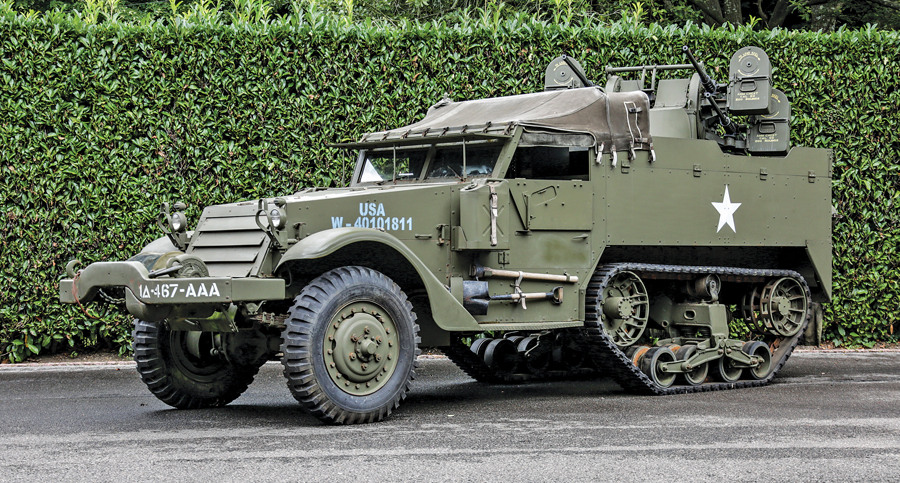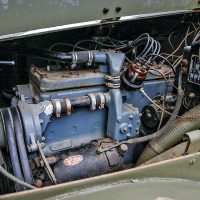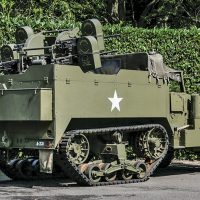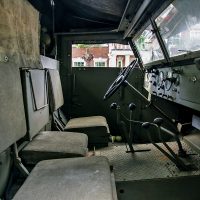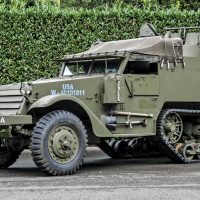SCM Analysis
Detailing
| Vehicle: | 1943 White M16 MGMC Half-Track |
| Years Produced: | 1943–44 |
| Number Produced: | 2,877 |
| Original List Price: | N/A |
| SCM Valuation: | $50,000–$120,000 |
| Tune Up Cost: | $350 |
| Distributor Caps: | $25 |
| Chassis Number Location: | Data plate on the dashboard, also alongside of the left front tire on the left frame rail |
| Engine Number Location: | Pad on the driver’s side of the engine block; lower front corner, below the water pump to engine-block hose, next to the generator |
| Club Info: | Military Vehicle Preservation Association (MVPA) |
| Website: | http://www.mvpa.org |
| Alternatives: | 1942–45 White/Autocar/Diamond T M2/M3 half track, 1942–45 International M5/M9A1 half track, 1940–44 White M3A1 Scout Car |
| Investment Grade: | B |
This half-track, Lot 193, sold for $48,200, including buyer’s premium, at RM Sotheby’s London, U.K., auction on October 24, 2019.
Before the United States marched into World War II, the Scout Car was the go-to light-armored battlefield workhorse. Built by White Motors, the M2 and M3 were the furthest development of wheeled Scout Car before the attack on Pearl Harbor.
Yet all-wheeled vehicles had their shortcomings on a muddy, shell-cratered battlefield.
The U.S. Army took an M2A1 Scout Car and added tracks to the rear, creating the T7. Almost an instant success, the T7 changed little before entering production as the M2 half-track. Autocar got the first contract to build the M2, but with more production capacity needed, White and Diamond T were brought in.
As an anti-aircraft platform, half-tracks started with independently mounted, manually operated .30- and .50-caliber Browning machine guns attached to pedestals or ring mounts.
The system was soon upgraded to electrically powered gun mounts with a single gunner operating up to four .50-cal machine guns. The highest evolution of this system was the Maxson M45 quad M2 .50-caliber machine-gun mount added to an M3 half-track built with hinged side armor — called the M16 Multiple Gun Motor Carriage. Our subject half-track is one of these vehicles.
As such, the M16 MGMC has generally been the top rung of collectibility for half-track types among historic-military-vehicle fans.
A changing market
In July 2014, during the Littlefield Collection auction of historic military vehicles, a very comparable M16 MGMC sold for a spectacular $201,250.
Our subject vehicle sold for $48,200 less than six years later.
Has the military-vehicle collector market taken that bad of a hit? Or was that 2014 sale a once-in-a-lifetime moon shot? Or did someone get a smoking-hot deal in London?
There are elements of the truth in all three scenarios.
The right time and place
The sale of the Littlefield Collection was a landmark event in the world of historic military vehicles.
The Littlefield Collection’s size and esoteric offerings made it a magnet for collectors. Bidders attempted to get a special vehicle, but they also had Plan B and even Plan C vehicles.
Such was the case with the Littlefield Collection’s M16 MGMC. The eventual high bidder came there to buy THAT half-track, while the under-bidder eventually settled for at least one of the others at the auction.
The Littlefield Collection auction set the record sale of an M16 MGMC. While that sale got the attention of most military-vehicle collectors, it didn’t spark price increases.
A buyer’s market
Since 2014, the market for collectible military vehicles has softened.
More estate collections have entered the market, and existing collectors are being more selective.
The market is especially soft for common and attainable military vehicles (mainly G503 WWII jeeps). However, prices are stagnant or falling for more esoteric pieces, such as our subject M16 MGMC.
Too posh a venue?
Our featured half-track was offered at a high-end collector-car auction, so it was something of an outlier on the docket. There wasn’t the mosh-pit atmosphere that is often seen when an auction caters to one specific type of vehicle.
While our half-track was offered as road-ready and legal in the U.K. — including the four dummy .50-caliber machine guns — being offered at a posh venue in London didn’t help.
The European vintage-military-vehicle community isn’t as interwoven into the general collector-car community as in the American market.
A web of regulations
One has to be well acquainted with national and international law when buying a retired military vehicle in a foreign country.
While there’ll be minimal issues registering this in EU countries (Brexit or not), bringing it back to the U.S. is a tricky affair. The U.S. State Department considers this a “weapon of war.” As such, the U.S. government requires rolls of red tape to proceed.
This is a task for specialists who’ve been there before. Even for them, at this price point, it may not pencil out to bring this one back to the U.S.
Condition counts
While our half-track was sent to a specialist “who spared no expense in returning it to running condition,” that does not equate to being an authentic, comprehensive restoration.
This work was also done at least a decade ago, and it’s starting to see some cosmetic unwinding. Half-tracks are high-maintenance beasts. Yet France and Israel kept using these well after World War II, so specialty parts availability is not too bad — provided you know with whom to deal and open up your checkbook.
At least this one had all the correct data plates with serial numbers on it — something the Littlefield M16 didn’t.
Still, not a bad sale
For the market as a whole, this half-track was somewhat well bought.
This is especially true if the new owner is a British or European collector enthusiast who’s had an M16 MGMC “on the radar” for some time. Also, if the buyer has the means to care for this — and feed it (high-priced European petrol rather than cheaper American gasoline.)
For almost anyone else in Europe or the U.K., this half-track is too much of a stretch — regardless of the auction price.
If it had tracks and tires on the ground in the United States, it would’ve been very well bought — but it didn’t, and it wasn’t. ♦
